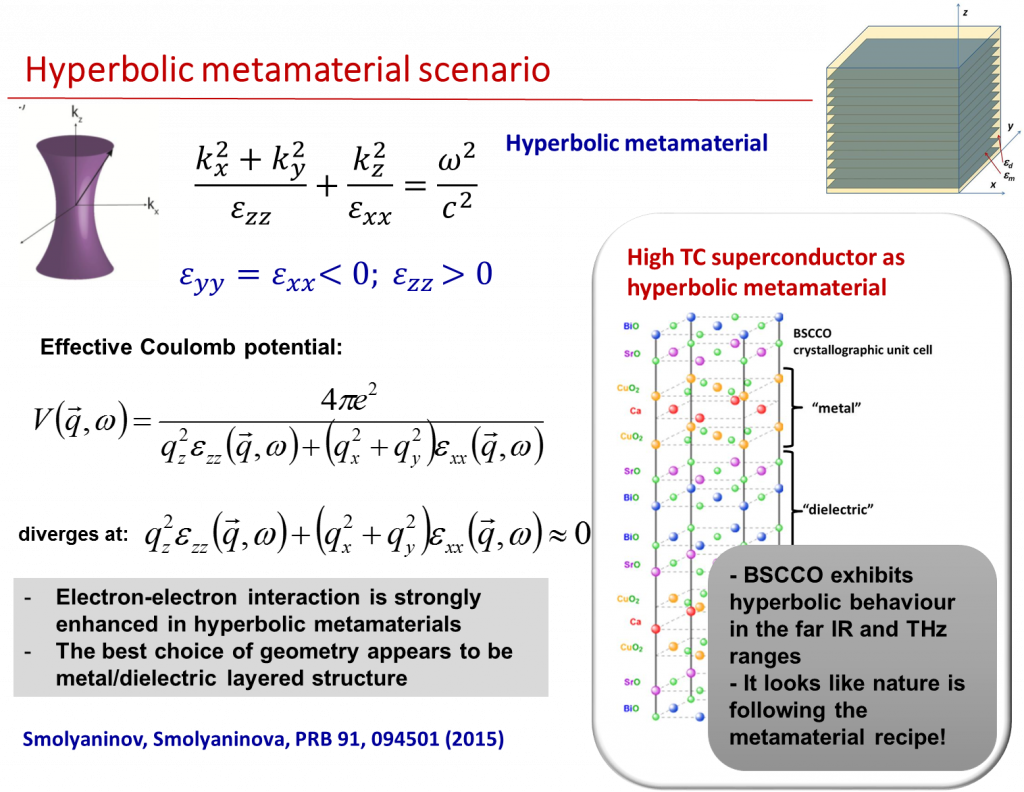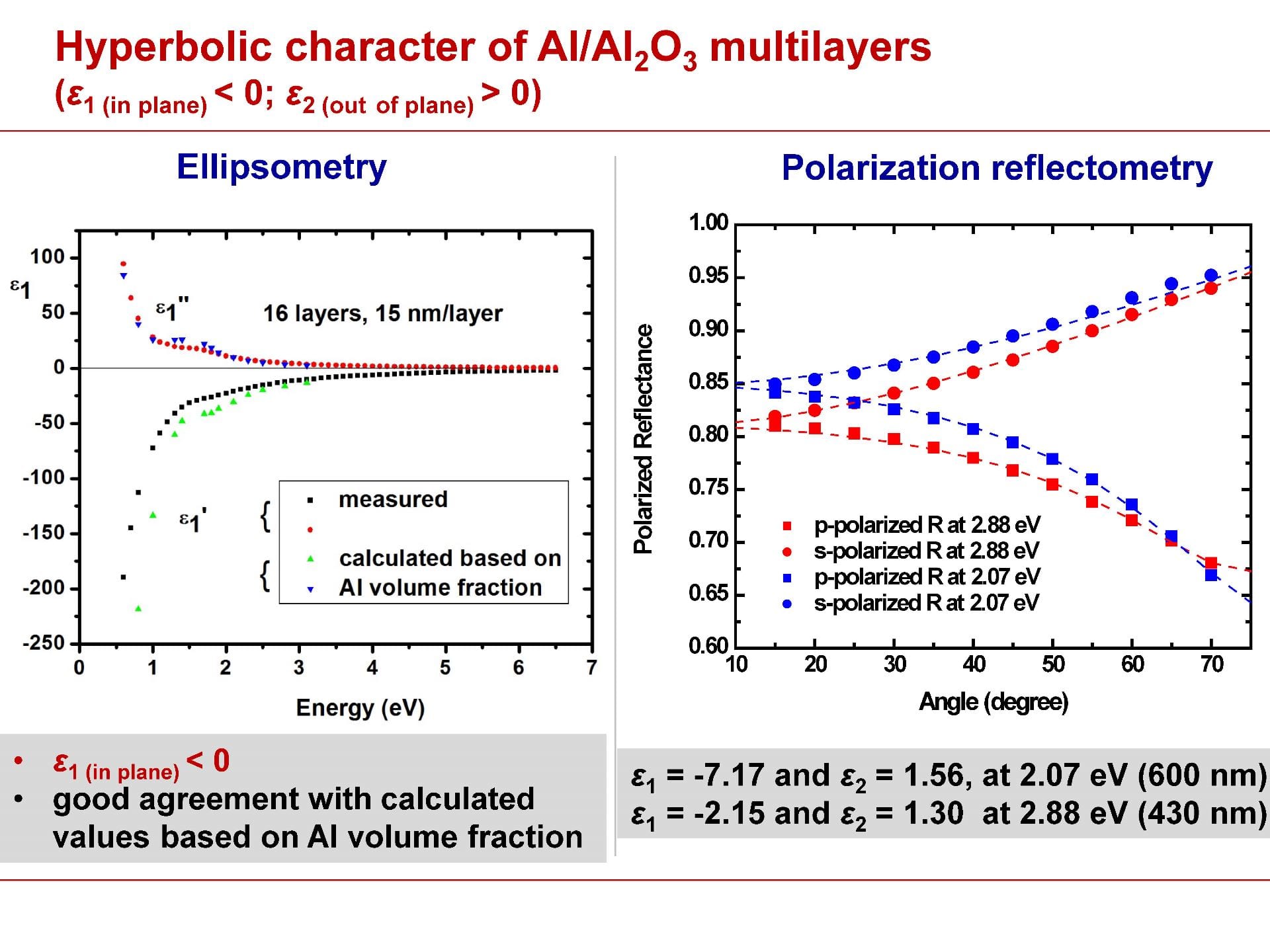Superconducting properties of a material, such as electron-electron interactions and the critical temperature of superconducting transition can be expressed via the effective dielectric response function εeff(q,ω) of the material. Such a description is valid on the spatial scales below the superconducting coherence length (the size of the Cooper pair), which equals ~100 nm in a typical BCS superconductor. Searching for natural materials exhibiting larger electron-electron interactions constitutes a traditional approach to high temperature superconductivity research. Here we point out that recently developed field of electromagnetic metamaterials deals with somewhat related task of dielectric response engineering on sub-100 nm scale. We argue that the metamaterial approach to dielectric response engineering may considerably increase the critical temperature of a composite superconductor-dielectric metamaterial.
Igor I. Smolyaninov and Vera N. Smolyaninova, “Is there a metamaterial rout to high temperature superconductivity?” Advances in Condensed Matter Physics 2014, 479635 (2014)
This work generated considerable media interest including MIT Technology Review, PhysicsWorld, etc.
Experimental demonstration of superconducting critical temperature increase in electromagnetic metamaterials
| We have demonstrated that recent developments in the field of electromagnetic metamaterials, such as the development of epsilon near zero (ENZ) and hyperbolic metamaterials, may be used to engineer the dielectric response of composite superconducting metamaterials on the sub-100 nm scale in order to increase the superconducting critical temperature of the metamaterial. Our proposal has been tested in experiments with metamaterials based on compressed mixtures of tin and barium titanate nanoparticles of varying composition. An increase of the critical temperature of the order of ΔTc ~ 0.15 K compared to bulk tin has been observed for ~ 40% volume fraction of barium titanate nanoparticles. | ![imgB[1]](https://wp.towson.edu/vsmolyan/files/2016/05/imgB1-pezufs.gif) ![imgF[1]](https://wp.towson.edu/vsmolyan/files/2016/05/imgF1-1nrhl9o.gif) |
![imgD[1]](https://wp.towson.edu/vsmolyan/files/2016/05/imgD1-2643z35.gif) ![img11[1]](https://wp.towson.edu/vsmolyan/files/2016/05/img111-yn8bh0.gif) |
|
| Proof of principle experiments: Tc increase in Sn/BTO | |||
| Vera N. Smolyaninova, Bradley Yost, Kathryn Zander, M. S. Osofsky, Heungsoo Kim, Shanta Saha, R. L. Greene, and Igor I. Smolyaninov, “Experimental demonstration of superconducting critical temperature increase in electromagnetic metamaterials,” Scientific Reports (Nature publishing group) 4, 7321 (2014). http://www.nature.com/articles/srep07321
This work generated considerable media interest including ExtremeTech, Superconductor Week etc.
|
|||
Using metamaterial nanoengineering to triple the superconducting critical temperature of bulk aluminum
| We have demonstrated the use of Al2O3-coated aluminium nanoparticles to form the recently proposed epsilon near zero (ENZ) core-shell metamaterial superconductor with a Tc that is three times that of pure aluminium. IR reflectivity measurements confirm the predicted metamaterial modification of the dielectric function thus demonstrating the efficacy of the ENZ metamaterial approach to Tc engineering. The developed technology enables efficient nanofabrication of bulk aluminium-based metamaterial superconductors. These results open up numerous new possibilities of considerable Tc increase in other simple superconductors. | ![epsilon[1]](https://wp.towson.edu/vsmolyan/files/2016/05/epsilon1-1y9dc13-300x225.gif) |
|
![Tc[1]](https://wp.towson.edu/vsmolyan/files/2016/05/Tc1-167wfd8.jpg) |
![core%20shell%20picture[1]](https://wp.towson.edu/vsmolyan/files/2016/05/core20shell20picture1-1o6locw.jpg) |
|
| Vera N. Smolyaninova, Kathryn Zander, Thomas Gresock, Christopher Jensen, Joseph C. Prestigiacomo, M. S. Osofsky & Igor I. Smolyaninov, “Using metamaterial nanoengineering to triple the superconducting critical temperature of bulk aluminum,” Scientific Reports (Nature publishing group) 5,15777 (2015) http://www.nature.com/articles/srep15777
This work was highlighted by SPIE NewsRoom, Superconductor Week and other media outlets.
Supported in part by NSF grant DMR-1104676 |
![TcAl[1]](https://wp.towson.edu/vsmolyan/files/2016/05/TcAl1-oennpm-300x250.jpg) |
Enhanced superconductivity in aluminum-based hyperbolic metamaterials
Enhanced superconductivity in aluminum-based hyperbolic metamaterials
One of the most important goals of condensed matter physics is materials by design, i.e. the ability to reliably predict and design materials with a set of desired properties. A striking example is the deterministic enhancement of the superconducting properties of materials. Recent experiments have demonstrated that the metamaterial approach is capable of achieving this goal, such as tripling the critical temperature Tc in Al-Al2O3 epsilon near zero (ENZ) core-shell metamaterial superconductors. Here, we demonstrate that an Al-Al2O3 hyperbolic metamaterial geometry is capable of a similar Tc enhancement, while having superior transport and magnetic properties compared to the core-shell metamaterial superconductors.
Vera N. Smolyaninova, Christopher Jensen, William Zimmerman, Joseph C. Prestigiacomo, Michael S. Osofsky, Heungsoo Kim, Nabil Bassim, Zhen Xing, Mumtaz M. Qazilbash & Igor I. Smolyaninov, Scientific Reports 6, 34140 (2016)




